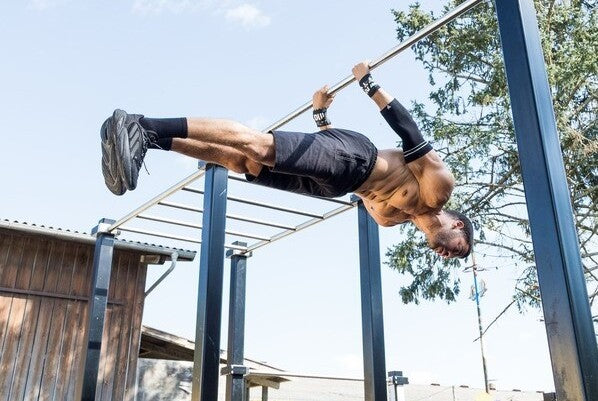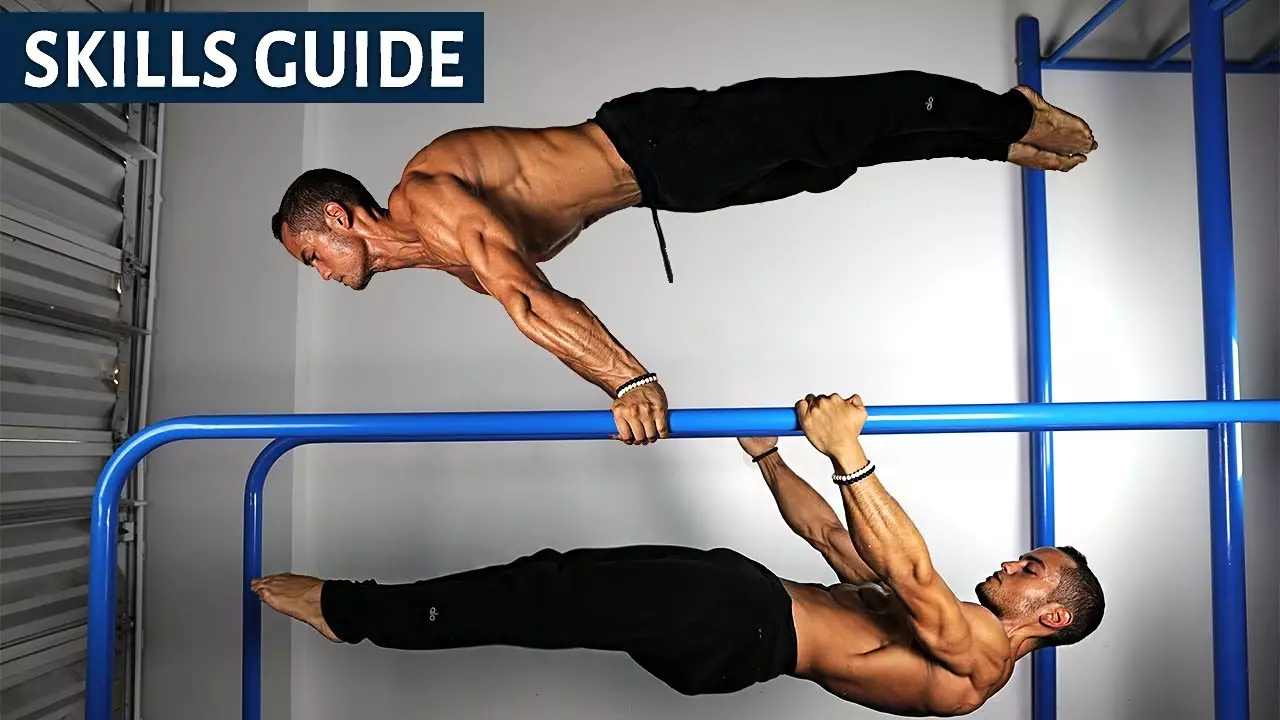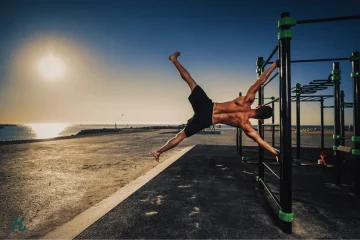As an Amazon Associate, I earn from qualifying purchases.
Calisthenics skills involve bodyweight exercises like push-ups and pull-ups. They focus on strength and flexibility training, using minimal equipment.
Calisthenics is a versatile fitness approach that can be done anywhere, making it accessible to people of all fitness levels. By mastering calisthenics skills, individuals can improve their overall physical fitness and body control. These exercises not only build strength but also enhance coordination and balance.
Practicing calisthenics regularly can lead to increased muscle tone, endurance, and agility. Whether you are a beginner or an advanced fitness enthusiast, incorporating calisthenics skills into your workout routine can help you achieve your fitness goals effectively.
Introduction To Calisthenics
Calisthenics Skills are a type of bodyweight training that involves using your own bodyweight to build strength and muscle. Common calisthenics skills include pull-ups, push-ups, dips, squats, and handstands. These exercises can be done anywhere, making them a convenient and effective way to improve overall fitness.
Calisthenics is a form of exercise that uses bodyweight movements to improve strength, flexibility, and overall fitness. It is a popular form of training that has gained a lot of attention in recent years. In this section, we will explore the rise of bodyweight training and the benefits of calisthenics.The Rise Of Bodyweight Training
Bodyweight training has been around for centuries, but it has gained popularity in recent years due to the rise of social media and the internet. Fitness enthusiasts and athletes alike have turned to calisthenics as a way to improve their physical abilities without the need for expensive gym equipment.Benefits Of Calisthenics
There are numerous benefits to incorporating calisthenics into your fitness routine. Here are just a few:- Improved strength and muscle tone
- Increased flexibility and mobility
- Better cardiovascular health
- Improved balance and coordination
- Lower risk of injury
Fundamental Principles
When it comes to mastering calisthenics skills, understanding the fundamental principles is crucial. These principles serve as the building blocks for progress and success in this discipline. By incorporating the following fundamental principles into your training regimen, you can lay a solid foundation for achieving your calisthenics goals.
Progressive Overload
Progressive overload is a key principle in calisthenics that involves gradually increasing the intensity of your workouts to stimulate muscle growth and strength development. This can be achieved by adding repetitions, sets, or incorporating more challenging variations of exercises as your strength improves. By consistently pushing your limits, you can continue to progress and enhance your calisthenics skills over time.
Consistency And Patience
Consistency and patience are essential virtues when it comes to mastering calisthenics skills. Consistently adhering to a structured training routine and being patient with the process are crucial for long-term progress. It’s important to understand that mastery in calisthenics is not achieved overnight but through dedicated and consistent practice. Embracing these fundamental principles will help you stay committed and motivated on your calisthenics journey.
Essential Calisthenics Exercises
Calisthenics is a form of exercise that utilizes body weight for strength training. Essential calisthenics exercises are fundamental for building a strong and agile physique. Incorporating these exercises into your routine can help improve muscle strength, endurance, and overall fitness.
Push-ups And Variations
Push-ups are a classic calisthenics exercise that targets the chest, shoulders, and triceps. They can be modified to suit different fitness levels and goals, including wide-arm push-ups to emphasize the chest muscles, diamond push-ups to target the triceps, and plyometric push-ups to enhance explosive power.
Pull-ups And Chin-ups
Pull-ups and chin-ups are effective exercises for developing upper body strength, particularly the back, biceps, and forearms. Variations such as wide-grip pull-ups, close-grip chin-ups, and muscle-ups provide diverse challenges and target different muscle groups.
Squats And Lunges
Squats and lunges are essential lower body exercises that help strengthen the quadriceps, hamstrings, glutes, and core. Variations such as jump squats, split squats, and pistol squats offer versatility and can be tailored to individual fitness levels and goals.
Core Development
Core development is a critical component of calisthenics training, as it forms the foundation for mastering advanced movements and enhancing overall strength and stability. By focusing on core exercises, individuals can improve their posture, balance, and functional strength, contributing to a more holistic approach to fitness.
Planks For Stability
One of the most effective core exercises in calisthenics is the plank. This static movement engages the entire core, including the abdominals, obliques, and lower back, promoting stability and endurance. Variations of the plank, such as side planks and plank variations with arm or leg lifts, can further challenge the core muscles, leading to enhanced strength and stability.
Advanced Core Movements
As individuals progress in their calisthenics journey, integrating advanced core movements becomes essential for continued development. Exercises such as dragon flags, hanging leg raises, and L-sits demand a high level of core strength and control, providing a pathway to achieving impressive calisthenics skills. These movements not only target the core but also engage the upper body and lower body, fostering full-body coordination and strength.
Upper Body Mastery
Achieving upper body mastery in calisthenics requires a combination of strength, balance, and control. It involves mastering various skills that push the limits of what the human body is capable of. By focusing on handstand skills and muscle-ups for strength and power, enthusiasts can develop an impressive level of upper body strength and control.
Handstand Skills
Handstand skills are a fundamental aspect of calisthenics, requiring a blend of strength, balance, and core stability. Practicing handstands not only improves upper body strength but also enhances overall body control and coordination. The ability to hold a perfect handstand demonstrates exceptional upper body strength and stability.
Muscle-ups For Strength And Power
Mastering muscle-ups is a true test of upper body strength and power. It involves pulling your body up and over a bar in one fluid motion, requiring a combination of explosive strength and coordination. Muscle-ups are an advanced calisthenics skill that not only showcases upper body strength but also challenges the entire body’s muscular coordination and power.

Credit: m.youtube.com
Lower Body Challenges
When it comes to calisthenics, mastering lower body challenges is a key focus for many enthusiasts. The lower body plays a vital role in overall strength, power, and agility, making it essential to target specific skills and exercises to enhance performance. In this post, we’ll explore some of the most effective lower body challenges in calisthenics, including pistol squats and explosive jump training.
Pistol Squats
Pistol squats are an advanced lower body exercise that requires significant strength, balance, and flexibility. This unilateral movement engages the quadriceps, hamstrings, glutes, and core, promoting stability and control. Mastering pistol squats not only enhances lower body strength but also improves functional mobility and overall athleticism.
Explosive Jump Training
Explosive jump training is a dynamic lower body challenge that focuses on developing power and explosiveness. Incorporating exercises like box jumps, tuck jumps, and broad jumps can significantly enhance lower body strength, speed, and vertical leap. This type of training is essential for athletes and fitness enthusiasts looking to improve their athletic performance and agility.
Flexibility And Mobility
When it comes to calisthenics, flexibility and mobility are crucial components that contribute to overall performance and injury prevention. Developing these attributes not only enhances the execution of calisthenics skills but also promotes better posture, range of motion, and joint health.
Dynamic Stretching
Dynamic stretching plays a pivotal role in preparing the body for calisthenics workouts. This form of stretching involves continuous movement patterns that mimic the actions performed during the workout. Engaging in dynamic stretching helps in warming up the muscles, increasing blood flow, and improving flexibility without compromising strength or power. Incorporating dynamic stretches into a calisthenics routine can help reduce the risk of injury and improve overall performance.
Mobility Routines
Mobility routines are essential for calisthenics practitioners as they focus on enhancing joint mobility and stability. These routines encompass a series of exercises designed to improve the range of motion in various joints, such as the hips, shoulders, and spine. By incorporating specific mobility exercises into their training regimen, individuals can achieve better body control, coordination, and movement efficiency, leading to improved performance in calisthenics skills.
Workout Routines
Mastering calisthenics skills can elevate your workout routine, offering a dynamic and effective way to build strength and flexibility. Incorporating bodyweight exercises like pull-ups, push-ups, and handstands can enhance your fitness journey, promoting functional strength and control.
Calisthenics is a form of exercise that uses your body weight to build strength and endurance. It is a great way to improve your fitness level and overall health. One of the key components of calisthenics is the workout routines that are designed to help you build specific skills. In this post, we will explore the different workout routines for calisthenics skills, including beginner workouts, intermediate challenges, and advanced skills workouts.Beginner Workouts
If you are new to calisthenics, it is important to start with the basics. The beginner workout routines are designed to help you build a foundation of strength and endurance. These workouts typically include exercises such as push-ups, squats, lunges, and planks. Sample Beginner Workout Routine:- 10 push-ups
- 10 squats
- 10 lunges (per leg)
- 30-second plank
- Repeat for 3 sets
Intermediate Challenges
Once you have built a solid foundation of strength and endurance, it’s time to take on some intermediate challenges. These workout routines are designed to help you build more advanced calisthenics skills, such as pull-ups, dips, and handstands. Sample Intermediate Workout Routine:- 10 pull-ups
- 10 dips
- 30-second handstand hold
- 10 single-leg squats (per leg)
- Repeat for 3 sets
Advanced Skills Workouts
If you are looking to take your calisthenics skills to the next level, the advanced skills workouts are for you. These workouts are designed to help you build complex skills such as muscle-ups, planches, and human flags. These workouts require a high level of strength and endurance, so it is important to make sure you have mastered the basics before attempting them. Sample Advanced Workout Routine:| Exercise | Reps |
|---|---|
| Muscle-ups | 5 |
| Planche push-ups | 5 |
| Human flags | 30 seconds |
| Handstand push-ups | 10 |
| Repeat for 3 sets |
Nutrition For Calisthenics
Proper nutrition is key to excelling in calisthenics. Your diet directly impacts your performance, energy levels, and recovery. Let’s delve into the essentials of nutrition for calisthenics athletes.
Macronutrient Basics
Macronutrients are the foundation of your diet, consisting of proteins, carbohydrates, and fats. Each plays a crucial role in fueling your body for calisthenics workouts.
Hydration And Performance
Staying hydrated is vital for optimal performance during calisthenics training. Dehydration can lead to decreased energy levels and hinder your progress.
Overcoming Plateaus
Plateaus are common in calisthenics training, often hindering progress. To continue advancing, it’s crucial to address these sticking points effectively.
Identifying Sticking Points
Recognizing specific areas where progress stagnates is essential. Common sticking points include lack of strength, poor form, and inadequate recovery.
Strategies For Continued Progress
- Implement progressive overload to challenge muscles and stimulate growth.
- Focus on form and technique to ensure optimal muscle engagement.
- Incorporate variety in your routine to prevent adaptation and keep progress consistent.
- Prioritize recovery through proper nutrition, hydration, and adequate rest.
- Seek guidance from experienced practitioners or trainers to refine your technique.
Community And Competition
Calisthenics skills not only offer physical benefits but also foster a sense of community and competition among enthusiasts. Finding a Calisthenics Community and engaging in Competing and Performing are essential aspects that enhance the overall calisthenics experience.
Finding A Calisthenics Community
Joining a calisthenics community provides support and motivation.
Local parks often host calisthenics groups and events.
Online forums offer a platform to connect with like-minded individuals.
Competing And Performing
Competing in calisthenics showcases skills and talents.
Performing routines in front of an audience boosts confidence.
Friendly competitions encourage skill improvement and camaraderie.
Safety And Injury Prevention
When practicing calisthenics skills, safety and injury prevention are of utmost importance to ensure a successful and fulfilling training experience.
Warm-up And Cool-down
Always perform a proper warm-up before engaging in any calisthenics routine to prepare your muscles and joints for activity.
Cool down after your workout to gradually lower your heart rate and prevent muscle soreness.
Listening To Your Body
Pay attention to any discomfort or pain during your workout as it may indicate a need to adjust your technique or intensity.
Rest when needed to allow your body to recover and prevent overuse injuries.
Tracking Progress
Tracking your progress in calisthenics skills is crucial for success and motivation. By setting goals, measuring improvements, and staying consistent, you can see tangible results over time.
Setting Goals
Establish clear and achievable objectives for each calisthenics skill you want to master. Break down your goals into smaller milestones to track your progress effectively.
Measuring Improvements
- Track the number of reps or duration you can hold a certain position.
- Take videos to analyze your form and technique for continuous improvement.
- Use a workout journal to record your sessions and note any progress or setbacks.

Credit: www.pullup-dip.com
The Future Of Calisthenics
The future of calisthenics is evolving rapidly as individuals and communities embrace this dynamic form of bodyweight training. With innovative techniques and a global movement gaining momentum, calisthenics is set to redefine fitness norms.
Innovations In Training
Calisthenics training continues to push boundaries with novel approaches such as freestyle calisthenics, weighted calisthenics, and the integration of gymnastics elements.
The Global Movement
Calisthenics enthusiasts worldwide are fostering a community that transcends borders, sharing skills, knowledge, and inspiring each other to achieve new heights in fitness.

Credit: arazi626.medium.com
Frequently Asked Questions
What Is Skill Work In Calisthenics?
Skill work in calisthenics involves practicing advanced movements like handstands, muscle-ups, and levers to improve strength and control. It focuses on developing body awareness and coordination for mastering challenging bodyweight exercises.
What Are The 4 Pillars Of Calisthenics?
The 4 pillars of calisthenics are strength, flexibility, balance, and control. These form the foundation for bodyweight exercises.
How To Learn Calisthenics Skills Fast?
To learn calisthenics skills fast, focus on consistent practice, proper form, and gradual progression. Incorporate strength training and flexibility exercises. Seek guidance from experienced practitioners or trainers. Stay dedicated and patient to see improvement over time.
What’s The Hardest Calisthenics Skill?
The hardest calisthenics skill is the human flag. It requires exceptional upper body and core strength.
Conclusion
Incorporating calisthenics skills into your fitness routine can enhance strength, flexibility, and overall performance. Whether you are a beginner or advanced practitioner, mastering these exercises can lead to significant improvements in your physical abilities. So, start practicing these skills and unlock your full potential today!
As an Amazon Associate, I earn from qualifying purchases.

